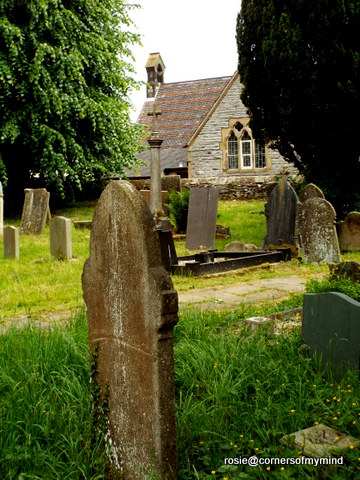There is a small car park at the top of the hill as you enter the village of Youlgreave in Derbyshire and we decided to park there and walk down the hill into the centre as the road is quite narrow and traffic is sometimes heavy as drivers weave their way around parked cars and other obstructions. Locals were waiting at bus stops along the way for the bus to Bakewell. The people we passed had a ready smile and a 'Good Morning' for visitors.
We could see the tower of All Saints' Parish Church as we walked down into the village. We did eventually walk as far as the church but first we had a smaller building to find.
Opposite the old Co-operative Grocery shop which is now a Youth Hostel stands The Conduit or Water Fountain.
Almost hidden by the Conduit Head or water fountain was the building we were looking for....
Thimble Hall
Thimble Hall was built in the 18th Century. It was a one up one down home with a ladder to the upper room. It was thought that a family of eight lived there at one time. It was last lived in as a family home in the 1930s and has been used since then as an Antiques shop, a Butcher's shop and also as a Cobbler's shop. It is a Grade II listed building.
Apparently, according to one source I read on line, Thimble Hall is in the Guinness Book of World Records as being the smallest detached house at 11ft 10ins by 10ft 3ins and 12ft 2ins high. It was sold at auction in 1999 with a guide price of £15,000 but it sold for £39,500 apparently bought by an ice cream maker from Chesterfield. Sadly it seems to stand empty at the moment although a lady was watering the plants on the side.
The Conduit Head is also a Grade II listed building made of grit stone ashlar and erected in 1829 by the Youlgreave Friendly Society of Women. Before this water reservoir was built families had to draw water from the nearby River Bradford.
From Thimble Hall and Conduit Head we walked along Church Street, past The Old Bakery, now a B&B establishment towards the church.
The Parish Church of All Saints' is, according to their guide book, one of the oldest and largest medieval churches in the Peak District. We had visited the churchyard before, a few years ago, looking for some of Paul's ancestors but hadn't been inside. Luckily we found the building open.
The interior is mostly Norman with the oldest parts in the nave dating from between 1150 and 1170. There is a Tudor roof and the usual Victorian restoration done between 1869 and 1871, the stained glass in the east window dates from this time. The Gothic style chancel dates from the 14th century with 15th century additions.

The glass in the east window was designed by Edward Burne Jones and made in the William Morris workshops. The table tomb in the centre of the chancel is a memorial to Thomas Cockayne a member of a prominent local family of the time.
He died in 1488 in a fight with Thomas Burdett of Pooley Park in Warwickshire as they were one their way to Polesworth church. The fight was apparently about a family marriage settlement. It is quite a small effigy, even though he was a grown man, done this way because he predeceased his father.
Above is the effigy from the 14th century which is thought to be of Sir John Rossington, he lies with his head on a pillow with a dog at his feet. He holds a heart in his hands.
Looking back from the chancel to the nave.
In the north aisle is a Jacobean memorial to Roger Rooe of nearby Alport who died in 1613 and also to his wife and their eight children.
The Norman font which belonged originally to Elton church and was moved to its present place in the 19th century.
Thought to be a 17th century burial slab this figure was moved inside the church for safe keeping.
A little part of the village school at the edge of the churchyard.
We liked the look of this old shop front opposite the church. The property is up for sale by auction, just like Thimble Hall was. I wonder who will buy it and what they will do with the building perhaps a family home, an art and craft gallery or a tea shop? Who knows.


















































